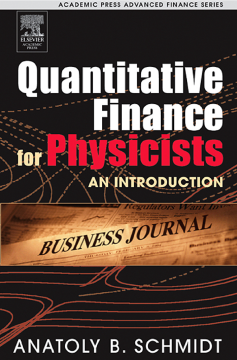
Additional Information
Book Details
Abstract
With more and more physicists and physics students exploring the possibility of utilizing their advanced math skills for a career in the finance industry, this much-needed book quickly introduces them to fundamental and advanced finance principles and methods.
Quantitative Finance for Physicists provides a short, straightforward introduction for those who already have a background in physics. Find out how fractals, scaling, chaos, and other physics concepts are useful in analyzing financial time series. Learn about key topics in quantitative finance such as option pricing, portfolio management, and risk measurement. This book provides the basic knowledge in finance required to enable readers with physics backgrounds to move successfully into the financial industry.
- Short, self-contained book for physicists to master basic concepts and quantitative methods of finance
- Growing field—many physicists are moving into finance positions because of the high-level math required
- Draws on the author's own experience as a physicist who moved into a financial analyst position
"… Schmidt's book is the most pedagogical among the few good econophysics books to have appeared in the last years. I am going to use it whenever teaching econophysics to young researchers.... A very positive contribution, giving the new generation of scientists a balanced, interdisciplinary, yet soundly professional background in this fascinating and promising field." —Sorin Solomon, Professor at the Racah Institute of Physics, Hebrew University of Jerusalem and Director of the Multi-Agent Systems Division at the Institute for Scientific Interchange, Torino
"…What amazes me most in this nicely crafted presentation of hot topics in econometrics, mathematical finance, econophysics, and agent-based modeling is how the selection of topics is well-informed and how these pour out smoothly. I will recommend this book to my own financial economics students as an up-to-date, quick reference companion to classes and the lab." —Sergio Da Silva, Department of Economics, Federal University of Santa Catarina, Brazil
